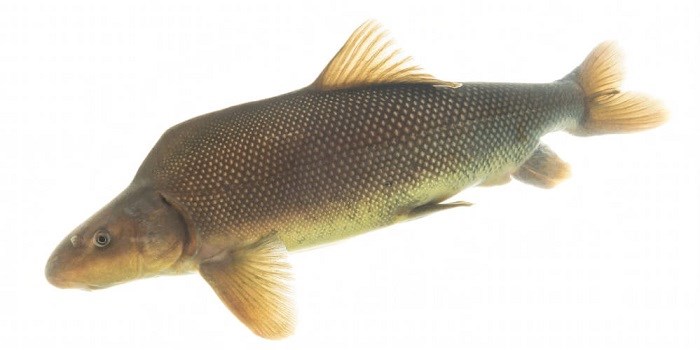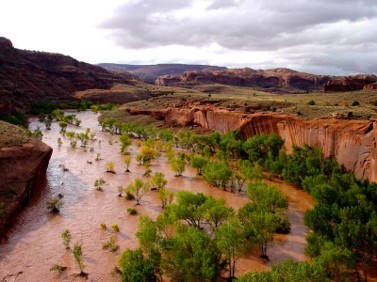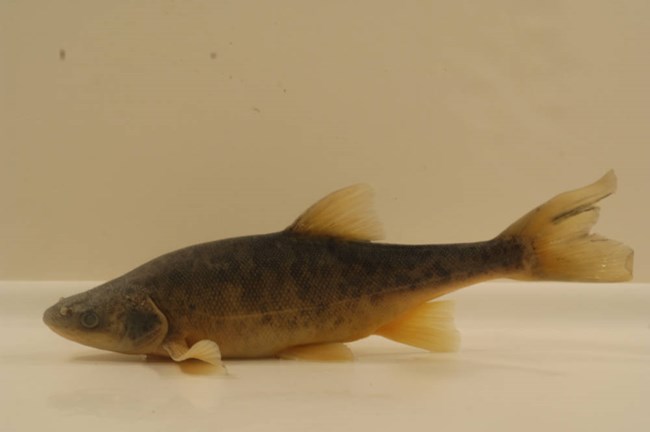Part of a series of articles titled NRCA 2022: Condition of Glen Canyon's Tributary Rivers and Associated Resources.
Article
Native Fish in Glen Canyon’s Tributary Rivers
Nearly 30 species of fish are known to inhabit the waters of Glen Canyon National Recreation Area (NRA). However, only eight of these species are native, meaning they occurred in Glen Canyon’s waters historically and were not introduced there by people. Fish are an important part of aquatic ecosystems. They are an integral part of food webs; some are herbivores and others are carnivores.

US Fish and Wildlife Service/Sam Stukel
Of the eight native fish species in Glen Canyon, four are federally listed under the Endangered Species Act (razorback sucker [Xyrauchen texanus], humpback chub [Gila cypha], bonytail chub [Gila elegans], and Colorado pikeminnow [Ptychocheilus lucius]), and four are part of a conservation/management effort by four states, including Arizona and Utah (bluehead sucker [Catostomus discobolus], flannelmouth sucker [Catostomus latipinnis], roundtail chub [Gila robusta], and speckled dace [Rhinichthys osculus]). This second group of native species has been studied less than other fish in the region, and, therefore, was one area of focus in our Park Conditions Summary assessment.
To learn more about the non-native fish (sportfish) of Glen Canyon in Lake Powell and in the Colorado River below the dam, click here.
Assessing conditions of fish species
A recent Natural Resource Condition Assessment (NRCA) through the NPS NRCA Program focused on water-related resources located away from Lake Powell and the mainstem Colorado River. NRCAs evaluate natural resource conditions so that parks can use the best available science to manage their resources. Fish were one of five focal resources selected for this project at Glen Canyon.For the study, ecologists at Utah State University gathered data and information from published and unpublished reports and databases. They used four indicators of condition—water quantity and availability, water quality, biological community, and habitat quality and availability—to assess the four non-listed fish species in the tributaries of interest. The study area included four of the largest tributaries of the Colorado River, the Escalante, Paria, San Juan, and Dirty Devil.
What did we learn?
Water Quantity and Availability
- The natural flow regime (the pattern of flow magnitude, timing, duration, etc.) is critical in supporting the ecological integrity of streams and rivers, and, therefore, the provision of suitable fish habitat. Departures from the natural flow regime can affect aquatic life by degrading the habitat and water quality and reducing diversity and abundance of organisms. Three of the four streams studied (Escalante, San Juan, and Dirty Devil) exhibited moderate departures from natural or historical conditions in total annual flow, seasonal flow, and variability in flow.
- The Paria River, however, did not appear to depart from natural conditions. These results suggest that water quantity and availability has been moderately degraded from natural or historical conditions, and the condition of water quantity and availability is fair.
Water Quality
- None of the four rivers where the fishes occur have significant impacts to water quality, but information is lacking for some types of contaminants (such as mercury). However, some water quality issues do exist. For example, a stretch of the Lower San Juan River within the park is listed as impaired by the Utah Department of Environmental Quality (partially due to the Gold King Mine spill of 2015), and a short stretch of the Paria River within the park is listed as impaired. For these reasons, the condition for this indicator is good/fair.

NPS Photo
Biological Community
- In the upper Escalante River, all four fish species are consistently present and data indicate stable populations. The fish community in this river in the park appears to be in good condition.
- In the lower Escalante and San Juan rivers, some native fish species are absent or severely reduced in numbers, and the community is dominated by non-native species. Therefore, the condition of the community is poor for the lower Escalante and San Juan rivers.
Habitat Quality and Availability
- The four fish species require different amounts of pools, runs, riffles, and low-velocity habitat, and a mix of various substrate features. Because habitat needs vary by species and available data are limited, condition for this indicator is unknown.
What can park managers do with this information and what questions remain?

US Fish and Wildlife Service/Matthew Patterson
- do threats from the loss of water sources for fish warrant additional monitoring and management actions?
- How will the small native fishes respond to invasive plant species control/removal along the Escalante River as it is restored to a pool-riffle habitat?
|
|
|
Information in this article was summarized from: Albright J and Others. 2022. Natural resource conditions at Glen Canyon National Recreation Area: Findings & management considerations for selected resources. Natural Resource Report. NPS/SCPN/NRR—2022/2374. National Park Service. Fort Collins, Colorado. https://doi.org/10.36967/nrr-2293112
Read More about the 2022 Glen Canyon NRCA Project >
Go to the NRCA Program Home >
Last updated: July 14, 2022
